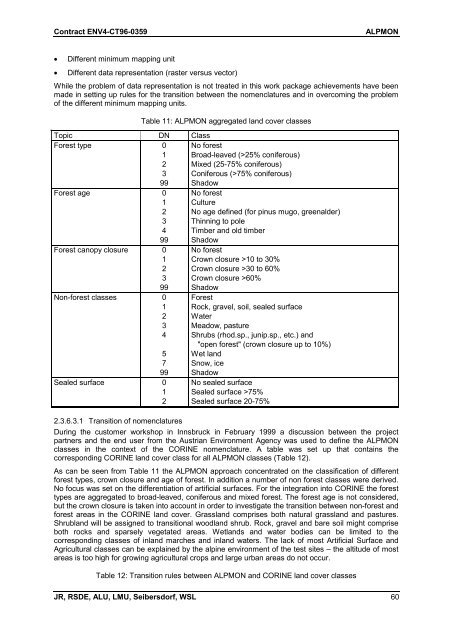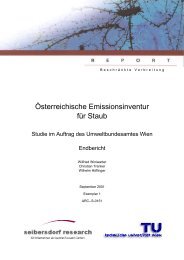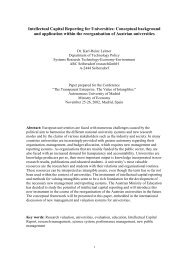ALPMON FINAL REPORT - ARC systems research
ALPMON FINAL REPORT - ARC systems research
ALPMON FINAL REPORT - ARC systems research
You also want an ePaper? Increase the reach of your titles
YUMPU automatically turns print PDFs into web optimized ePapers that Google loves.
Contract ENV4-CT96-0359 <strong>ALPMON</strong><br />
� Different minimum mapping unit<br />
� Different data representation (raster versus vector)<br />
While the problem of data representation is not treated in this work package achievements have been<br />
made in setting up rules for the transition between the nomenclatures and in overcoming the problem<br />
of the different minimum mapping units.<br />
Topic DN Class<br />
Forest type 0<br />
1<br />
2<br />
3<br />
99<br />
Forest age 0<br />
1<br />
2<br />
3<br />
4<br />
99<br />
Forest canopy closure 0<br />
1<br />
2<br />
3<br />
99<br />
Non-forest classes 0<br />
1<br />
2<br />
3<br />
4<br />
5<br />
7<br />
99<br />
Sealed surface 0<br />
1<br />
2<br />
Table 11: <strong>ALPMON</strong> aggregated land cover classes<br />
No forest<br />
Broad-leaved (>25% coniferous)<br />
Mixed (25-75% coniferous)<br />
Coniferous (>75% coniferous)<br />
Shadow<br />
No forest<br />
Culture<br />
No age defined (for pinus mugo, greenalder)<br />
Thinning to pole<br />
Timber and old timber<br />
Shadow<br />
No forest<br />
Crown closure >10 to 30%<br />
Crown closure >30 to 60%<br />
Crown closure >60%<br />
Shadow<br />
Forest<br />
Rock, gravel, soil, sealed surface<br />
Water<br />
Meadow, pasture<br />
Shrubs (rhod.sp., junip.sp., etc.) and<br />
"open forest" (crown closure up to 10%)<br />
Wet land<br />
Snow, ice<br />
Shadow<br />
No sealed surface<br />
Sealed surface >75%<br />
Sealed surface 20-75%<br />
2.3.6.3.1 Transition of nomenclatures<br />
During the customer workshop in Innsbruck in February 1999 a discussion between the project<br />
partners and the end user from the Austrian Environment Agency was used to define the <strong>ALPMON</strong><br />
classes in the context of the CORINE nomenclature. A table was set up that contains the<br />
corresponding CORINE land cover class for all <strong>ALPMON</strong> classes (Table 12).<br />
As can be seen from Table 11 the <strong>ALPMON</strong> approach concentrated on the classification of different<br />
forest types, crown closure and age of forest. In addition a number of non forest classes were derived.<br />
No focus was set on the differentiation of artificial surfaces. For the integration into CORINE the forest<br />
types are aggregated to broad-leaved, coniferous and mixed forest. The forest age is not considered,<br />
but the crown closure is taken into account in order to investigate the transition between non-forest and<br />
forest areas in the CORINE land cover. Grassland comprises both natural grassland and pastures.<br />
Shrubland will be assigned to transitional woodland shrub. Rock, gravel and bare soil might comprise<br />
both rocks and sparsely vegetated areas. Wetlands and water bodies can be limited to the<br />
corresponding classes of inland marches and inland waters. The lack of most Artificial Surface and<br />
Agricultural classes can be explained by the alpine environment of the test sites – the altitude of most<br />
areas is too high for growing agricultural crops and large urban areas do not occur.<br />
Table 12: Transition rules between <strong>ALPMON</strong> and CORINE land cover classes<br />
JR, RSDE, ALU, LMU, Seibersdorf, WSL 60




